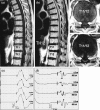Quantitative assessment of myelopathy patients using motor evoked potentials produced by transcranial magnetic stimulation
- PMID: 20033461
- PMCID: PMC2899952
- DOI: 10.1007/s00586-009-1246-8
Quantitative assessment of myelopathy patients using motor evoked potentials produced by transcranial magnetic stimulation
Abstract
Motor evoked potentials (MEPs) study using transcranial magnetic stimulation (TMS) may give a functional assessment of corticospinal conduction. But there are no large studies on MEPs using TMS in myelopathy patients. The purpose of this study is to confirm the usefulness of MEPs for the assessment of the myelopathy and to investigate the use of MEPs using TMS as a screening tool for myelopathy. We measured the MEPs of 831 patients with symptoms and signs suggestive of myelopathy using TMS. The MEPs from the abductor digiti minimi (ADM) and abductor hallucis (AH) muscles were evoked by transcranial magnetic brain stimulation. Central motor conduction time (CMCT) is calculated by subtracting the peripheral conduction time from the MEP latency. Later, 349 patients had surgery for myelopathy (operative group) and 482 patients were treated conservatively (nonoperative group). CMCTs in the operative group and nonoperative group were assessed. MEPs were prolonged in 711 patients (86%) and CMCTs were prolonged in 493 patients (59%) compared with the control patients. CMCTs from the ADM and AH in the operative group were significantly more prolonged than that in the nonoperative group. All patients in the operative group showed prolongation of MEPs or CMCTs or multiphase of the MEP wave. MEP abnormalities are useful for an electrophysiological evaluation of myelopathy patients. Moreover, MEPs may be effective parameters in spinal pathology for deciding the operative treatment.
Figures




Similar articles
-
Electrophysiological assessments of the motor pathway in diabetic patients with compressive cervical myelopathy.J Neurosurg Spine. 2015 Dec;23(6):707-14. doi: 10.3171/2015.3.SPINE141060. Epub 2015 Sep 4. J Neurosurg Spine. 2015. PMID: 26340381
-
Electrophysiological evidence of functional improvement in the corticospinal tract after laminoplasty in patients with cervical compressive myelopathy: clinical article.J Neurosurg Spine. 2014 Aug;21(2):210-6. doi: 10.3171/2014.4.SPINE13545. Epub 2014 May 23. J Neurosurg Spine. 2014. PMID: 24855997
-
Assessment of cervical myelopathy using transcranial magnetic stimulation and prediction of prognosis after laminoplasty.Spine (Phila Pa 1976). 2008 Jan 1;33(1):E15-20. doi: 10.1097/BRS.0b013e31815e5dae. Spine (Phila Pa 1976). 2008. PMID: 18165736
-
Central motor conduction time.Handb Clin Neurol. 2013;116:375-86. doi: 10.1016/B978-0-444-53497-2.00031-0. Handb Clin Neurol. 2013. PMID: 24112910 Review.
-
Central motor conduction studies in patients with spinal cord disorders: a review.Spinal Cord. 2014 Jun;52(6):420-7. doi: 10.1038/sc.2014.48. Epub 2014 Apr 22. Spinal Cord. 2014. PMID: 24752292 Review.
Cited by
-
Multimodal Evaluation of TMS - Induced Somatosensory Plasticity and Behavioral Recovery in Rats With Contusion Spinal Cord Injury.Front Neurosci. 2019 Apr 24;13:387. doi: 10.3389/fnins.2019.00387. eCollection 2019. Front Neurosci. 2019. PMID: 31068784 Free PMC article.
-
Research progress on the application of transcranial magnetic stimulation in spinal cord injury rehabilitation: a narrative review.Front Neurol. 2023 Jul 18;14:1219590. doi: 10.3389/fneur.2023.1219590. eCollection 2023. Front Neurol. 2023. PMID: 37533475 Free PMC article. Review.
-
A supplementary system for a brain-machine interface based on jaw artifacts for the bidimensional control of a robotic arm.PLoS One. 2014 Nov 12;9(11):e112352. doi: 10.1371/journal.pone.0112352. eCollection 2014. PLoS One. 2014. PMID: 25390372 Free PMC article.
-
Diagnostic and prognostic value of navigated transcranial magnetic stimulation to assess motor function in patients with acute traumatic spinal cord injury.Brain Spine. 2025 Mar 7;5:104229. doi: 10.1016/j.bas.2025.104229. eCollection 2025. Brain Spine. 2025. PMID: 40165994 Free PMC article.
-
Evaluation of corticospinal excitability in cervical myelopathy, before and after surgery, with transcranial magnetic stimulation: a pilot study.Eur Spine J. 2013 Jan;22(1):189-96. doi: 10.1007/s00586-012-2554-y. Epub 2012 Nov 7. Eur Spine J. 2013. PMID: 23132280 Free PMC article.
References
-
- Linden RD, Zhang YP, Burke DA, et al. Magnetic motor evoked potential monitoring in the rat. J Neurosurg. 1999;91:205–210. - PubMed
-
- Staudt M, Krageloh-Mann I, Holthausen H, et al. Searching for motor functions in dysgenic cortex: a clinical transcranial magnetic stimulation and functional magnetic resonance imaging study. J Neurosurg. 2004;101:69–77. - PubMed
MeSH terms
LinkOut - more resources
Full Text Sources
Medical

